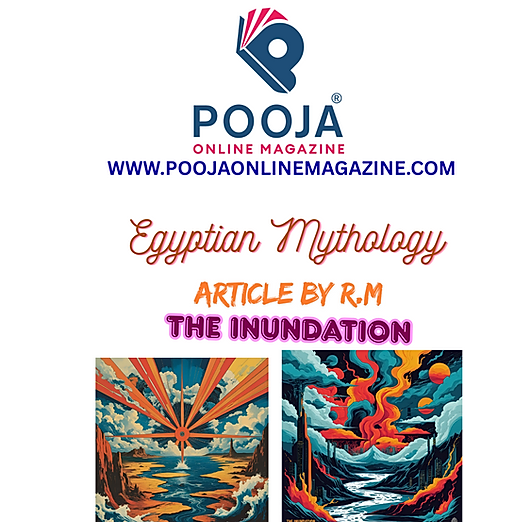
Egyptian Mythology
The Inundation

The air above the land of Kemet, ancient Egypt, shimmered with the relentless heat of late summer. The sun, Ra himself, beat down with an intensity that promised desiccation. Yet, beneath this searing sky, the people did not despair. Instead, a palpable anticipation, a quiet hum of hope, resonated through every mud-brick village, every bustling city, and along every parched field bordering the Great River. For soon, the Inundation would come.
This was no mere flood; it was the annual, miraculous heart-beat of Egypt, the very pulse of life that defined their existence for millennia. Far away, in the highlands of distant Ethiopia and the heart of Central Africa, the torrential monsoon rains and melting snows had begun their arduous journey. Swollen tributaries fed the mighty Nile, sending a torrent of life-giving water thundering northward, towards the thirsty land of the pharaohs.
As the days of the season of Akhet – the Inundation – arrived, the murmuring grew louder. First, the river would swell, its familiar banks disappearing as the waters crept higher, slowly, inexorably, claiming the parched earth. Then, the transformation. The Nile, once a ribbon of blue, would become a vast, churning lake, its waters tinged a rich, chocolate brown. This color was not a sign of dirt, but of deliverance; it was the precious gift of silt, the nutrient-rich sediment scoured from the distant mountains, now suspended in the life-blood of Egypt.
For nearly four months, the land lay submerged, seemingly drowned. But this was not death, it was a profound cleansing, a divine fertilization. Farmers, their fields temporarily out of reach, turned their efforts to the pharaoh's monumental projects – the colossal temples and eternal tombs – a communal rhythm born from the river's grand cycle. They knew, with an ancestral certainty, that the river would retreat.
And retreat it did. As the sun shifted and the season of Peret, the Emergence, dawned, the waters slowly receded, leaving behind a glistening, black carpet of unparalleled fertility. This was the true magic: the Nile had not just watered the land, it had renewed it, laying down a fresh, rich topsoil, rendering the ground infinitely receptive to the seeds. No need for complex fertilizers, no struggle against barrenness; the Great River, in its benevolent wisdom, had provided all.
Then came the furious, joyous labor. Farmers, guided by the ingenuity of their ancestors, repaired the intricate network of dikes and canals, carefully constructed to manage and distribute the precious waters across their basin fields. They would cast their seeds into the still-moist, black earth, a profound act of faith and partnership with the divine. The wheat and barley would burst forth, emerald green, stretching towards the ever-present sun, promising bountiful harvests.
The Inundation was not merely an agricultural phenomenon; it was the bedrock of Egyptian identity. It shaped their calendar, with its three distinct seasons mirroring the river's flow. It fueled their economy, providing the surplus grain that allowed for specialization of labor, the growth of cities, and the vast wealth that built their enduring civilization. The pharaoh, the living Horus, was seen as the crucial intermediary, his very existence tied to the success of the Inundation, his rituals and reign ensuring its benevolent return. A flood too low meant famine and despair; one too high meant destruction and chaos. The precise, measured rise was the key to prosperity.
Above all, the Inundation was a profound religious experience. Hapi, the pot-bellied god of the Nile flood, was revered, his image etched into temple walls. The annual cycle of the river – the land's seeming death, its glorious rebirth – mirrored the sacred myth of Osiris, slain and resurrected by Isis, offering the Egyptians a potent metaphor for their own journey into the afterlife. Every year, as the waters rose, they were reminded of the eternal cycles of life, death, and triumphant renewal.
Even today, though the grand dams of the modern age have tamed its wild embrace, the memory of the Inundation whispers through the winds that sweep across the Nile Valley. It remains the timeless testament to a civilization built not just on stone and sand, but on the enduring, life-giving power of a river, a truly miraculous gift that flowed from the heart of Africa, nourishing the very soul of ancient Egypt.

